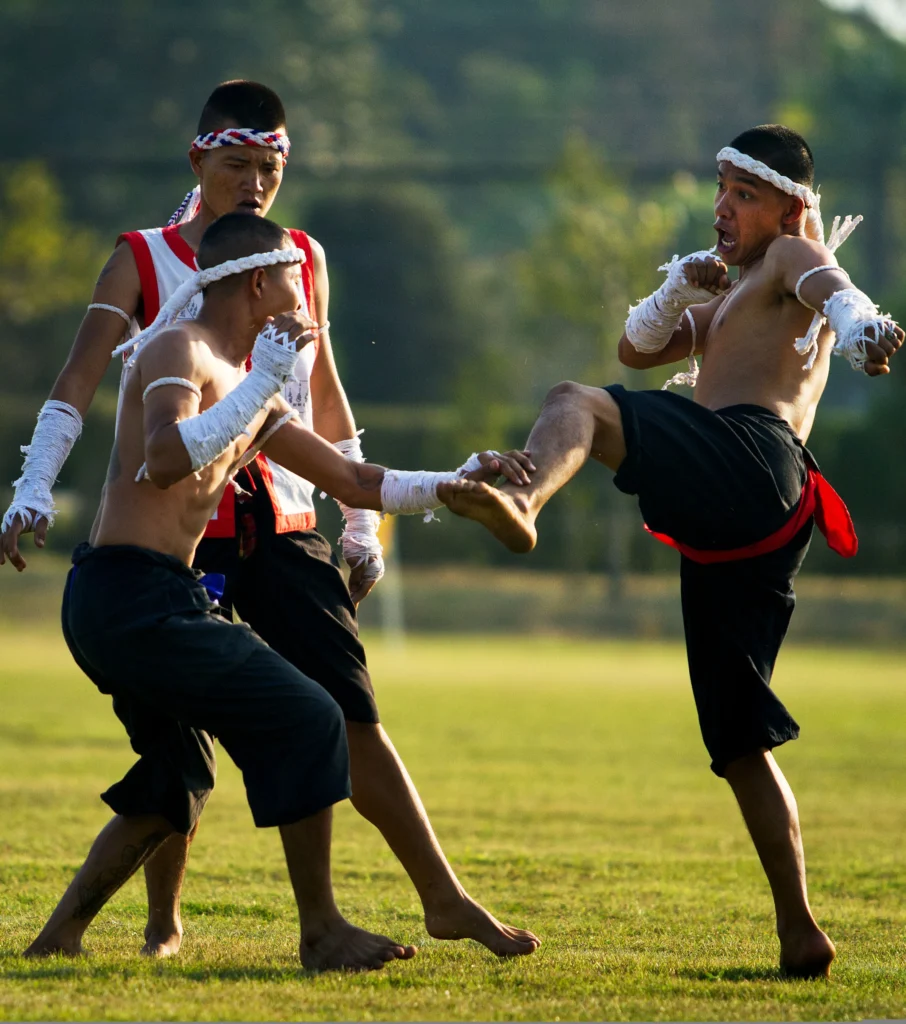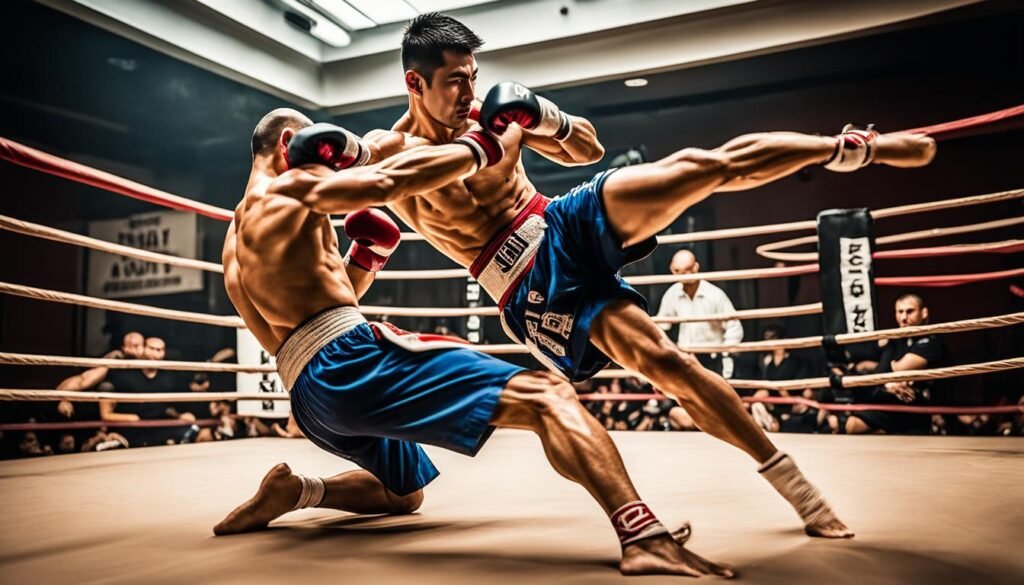It may surprise you to learn that Muay Boran, the ancient Thai martial art, predates modern Muay Thai by over a hundred years. Thai warriors engaged in this age-old combat sport, also referred to as “ancient boxing”, as a rite of passage. It has strong cultural origins. Muay Boran is a broad style of fighting that includes grappling and strikes with the fist, shin, and knee.
Let’s examine the beginnings, characteristics, and legacy of this ancient fighting sport.
Table of Contents
Key Takeaways
- Muay Boran is an ancient martial art from Thailand that predates modern Muay Thai.
- It originated in the 13th century and was practiced by Thai soldiers as a system of self-defense and training.
- Muay Boran includes a wide range of techniques, including strikes with fists, shins, knees, and grappling techniques.
- There are distinct differences between Muay Boran and Muay Thai, with Muay Boran allowing for lethal strikes and forbidden techniques.
- Despite its decline as a competitive sport, Muay Boran holds a significant place in Thai culture and is considered a cultural heritage.
Origins and Evolution of Muay Boran
Muay Boran, the ancient precursor to modern Muay Thai, has a fascinating history that dates back to the 13th century. Originating in the Sukhothai Kingdom of Thailand, Muay Boran was initially developed as a combat system for soldiers engaged in close-quarters combat. Over time, it grew in popularity and evolved into a highly respected combat sport and a form of entertainment.
During the Burmese-Siamese War in the 18th century, a legendary figure by the name of Nai Khanomtom emerged. He was a skilled Muay Boran fighter who showcased his exceptional combat skills in a tournament, defeating numerous Burmese opponents. Nai Khanomtom’s victory cemented his place in Muay Boran history and solidified the art’s reputation as a formidable fighting style.
In the early 20th century, Muay Boran underwent a formalization process, resulting in the development of distinct regional styles. These styles, such as Muay Lopburi, Muay Korat, and Muay Chaiya, represented different parts of Thailand and showcased the diverse techniques and interpretations of the ancient art.
However, Muay Boran’s popularity declined with the introduction of modern rules and equipment in the 1930s. This gave rise to the sport of Muay Thai, which focused on a more regulated and standardized version of the ancient martial art. Despite its decline as a competitive sport, Muay Boran’s legacy lives on through the efforts of practitioners and the preservation of its traditional combat skills and techniques.
The Evolution of Muay Boran
As Muay Boran evolved over the centuries, it became deeply ingrained in the fabric of Thai martial arts and cultural heritage. The art form captured the essence of ancient Thai boxing, encompassing a wide range of striking techniques, grappling maneuvers, and lethal strikes that are not seen in modern Muay Thai.
“Muay Boran represents the roots of our martial arts heritage, showcasing the raw power and traditional combat skills that have been passed down through generations.” – Kru Pichai, Muay Boran teacher
While Muay Boran’s techniques and rituals differ from Muay Thai, both arts share a common history and lineage. Muay Boran practitioners value tradition, with training incorporating not only physical conditioning but also mental discipline and respect for the art’s cultural significance.
To this day, fighters and enthusiasts continue to explore the rich history and techniques of Muay Boran, ensuring that the ancient martial art remains a vital part of Thai martial arts and a symbol of cultural identity.
Distinguishing Muay Boran from Muay Thai
Although Muay Boran and Muay Thai share similar roots, there are distinct differences between the two martial arts.
- Techniques: Muay Boran encompasses a broader range of techniques, including lethal strikes and grappling maneuvers, while Muay Thai focuses on a regulated set of strikes with both hands and legs.
- Rituals and practices: Muay Boran incorporates traditional rituals and practices, such as the Wai Kru and Ram Muay, which are not present in modern Muay Thai.
- Forbidden techniques: Certain strikes to the groin and flying knees to the head, which are forbidden in Muay Thai, are allowed in Muay Boran.
Despite these differences, both arts celebrate the rich heritage and warrior traditions of Thailand, with each offering a unique glimpse into the country’s ancient martial arts history.
The Distinctions Between Muay Boran and Muay Thai
Muay Boran and Muay Thai share many similarities but also have distinct differences that set them apart from each other. While both martial arts originated in Thailand and involve striking techniques, Muay Boran encompasses a broader range of techniques, including lethal strikes and grappling techniques, that are forbidden in modern Muay Thai.
In Muay Boran, fighters can utilize various body parts as weapons, including fists, shins, knees, and even their heads. This ancient martial art emphasizes the importance of versatility and utilizes a wider array of striking techniques compared to its modern counterpart, Muay Thai. The inclusion of lethal strikes grants Muay Boran a more dangerous and lethal reputation.
Furthermore, Muay Boran incorporates traditional rituals and practices that add cultural depth to the martial art. The Wai Kru, a ritual dance performed before a fight, pays homage to teachers, ancestors, and the spirits. The Ram Muay, a ceremonial movement performed at the start of each round, allows fighters to showcase their individual styles and pay respects to their trainers.
“Muay Boran allows fighters to utilize a wider range of techniques, including lethal strikes and grappling maneuvers, that are not permitted in the regulated sport of Muay Thai.”
On the other hand, Muay Thai is a regulated sport that focuses on a specific set of strikes with both hands and legs. Fighters wear gloves and follow specific rules, such as prohibiting strikes to the groin and flying knees to the head. This emphasis on safety ensures that the sport can be practiced competitively with reduced risk of severe injury.
Here is a comparison between Muay Boran and Muay Thai:
| Muay Boran | Muay Thai |
|---|---|
| Includes lethal strikes and grappling techniques | Focuses on regulated strikes with hands and legs |
| Allows the use of fists, shins, knees, and head as weapons | Emphasizes strikes with gloves, following specific rules |
| Incorporates traditional rituals like Wai Kru and Ram Muay | Lacks traditional rituals |

Despite their differences, both Muay Boran and Muay Thai have their place in the world of martial arts, showcasing the rich cultural heritage and fighting traditions of Thailand. Whether it be the raw and versatile techniques of Muay Boran or the regulation and sport aspect of Muay Thai, these forms of combat continue to captivate enthusiasts around the globe.
The Legacy and Modern Practice of Muay Boran
Despite its decline as a competitive sport, Muay Boran holds a significant place in Thai culture and heritage. The ancient martial art is now primarily practiced for exhibition and entertainment purposes, with demonstrations that showcase its techniques and traditions.
One of the notable aspects of Muay Boran is its cultural heritage value. It is deeply rooted in Thai history and reflects the warrior traditions of the country. The practice of Muay Boran not only preserves the techniques and skills of the ancient martial art but also keeps alive the cultural identity and pride associated with it.
To learn Muay Boran, there are specialized training courses and experienced Muay Boran teachers available. These instructors carry on the knowledge and pass it down to the next generation, ensuring the preservation of this traditional art form.

If you’re interested in learning Muay Boran, there are several renowned places in Thailand where you can explore this martial art. The Muay Thai Conservation Center in Bangkok, the Baan Chang Thai Arts School, and Tiger Muay Thai in Phuket are just a few examples of institutions that offer Muay Boran training.
Additionally, the popularity of movies like “Ong-Bak” has contributed to raising awareness and generating interest in Muay Boran. These films have showcased the ancient martial art to a global audience, further highlighting its significance and attracting enthusiasts from all around the world.
By practicing and promoting Muay Boran, individuals and organizations contribute to the preservation of this cultural heritage and ensure that the traditional art form continues to thrive for generations to come.
“Muay Boran not only represents the ancient combat skills of Thailand but also embodies our rich cultural heritage. It is our responsibility to pass on this legacy to future generations.” – Muay Boran Teacher
Conclusion
Muay Boran is a historical martial art that is deeply ingrained in Thai tradition and culture. Muay Boran is older than modern Muay Thai, having originated in the 13th century as a means of both self-defense and combat. Thai military trained in hitting and grappling, among other tactics, which later became a well-liked combat sport.
With the advent of contemporary laws and gear, Muay Boran saw a drop in popularity, but it is still a cultural treasure with a strong foundation in Thailand’s warrior traditions. Because of the commitment of knowledgeable instructors and practitioners, as well as the preservation of its methods and customs, Muay Boran’s legacy endures.
As a historical combat sport, Muay Boran continues to captivate enthusiasts and curiosity-seekers alike. Its significance extends beyond the physical practice, representing the resilience, determination, and warrior spirit of the Thai people. In honor of this ancient martial art, efforts are being made to safeguard its heritage and promote its cultural value.
For those interested in delving into the ancient world of Muay Boran, various training courses and experienced teachers are available. The Muay Thai Conservation Center in Bangkok, Baan Chang Thai Arts School, and Tiger Muay Thai in Phuket are renowned establishments where individuals can learn the art form’s techniques firsthand. By embracing and preserving Muay Boran, both its historical importance and cultural warrior traditions can continue to thrive for generations to come.
Beyond only fighting skills, Muay Boran’s warrior spirit and tenacity are invaluable. They convey a great deal about the beliefs and life events that molded a civilization. I am a big fan of cultural variety, and it’s always beautiful to see people trying to preserve their culture, thus I fully encourage initiatives to spread awareness of and celebration for this distinctive martial art style.
FAQ
What is Muay Boran?
Muay Boran, also known as “ancient boxing,” is a traditional martial art from Thailand that predates modern Muay Thai. It encompasses a wide range of techniques and plays a significant role in Thai culture and heritage.
When did Muay Boran originate?
Muay Boran originated in the 13th century in the Sukhothai Kingdom of Thailand.
Is Muay Thai and Muay Boran the same?
No, Muay Thai and Muay Boran are distinct. Muay Boran is the ancient precursor to Muay Thai, encompassing a broader range of techniques, while Muay Thai is a modernized ring sport.
Can you still learn Muay Boran?
Yes, Muay Boran classes are available, with some gyms like Rawai Muay Thai offering lessons. Private sessions with certified trainers are also an option.
How many Muay Boran styles are there?
Muay Boran includes various styles such as Muay Korat, Muay Chaiya, Muay Lopburi, Muay Uttaradit, Muay Wanorn, Muay Lert Rit, Combat Muay Boran, Muay Chaisawat, and more, showcasing a diverse range within the martial art.
Is Ong Bak Muay Thai or Muay Boran?
Ong Bak features Tony Jaa’s expertise in Muay Boran, highlighting it as a precursor to Muay Thai. Therefore, Ong Bak is associated with Muay Boran rather than Muay Thai.
Is Muay Boran still practiced today?
Yes, Muay Boran is still practiced today primarily for exhibition and entertainment purposes. There are specialized training courses and teachers who pass on the knowledge and traditions of Muay Boran.

